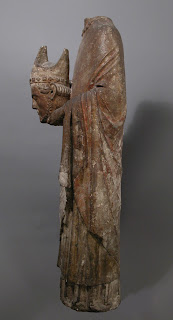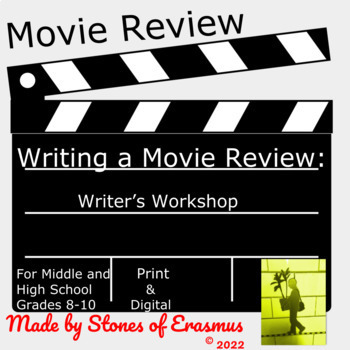Hi, I’m Greig — welcome! Here you’ll find sharp writing, creative ideas, and standout resources for teaching, thinking, making, and dreaming in the middle and high school ELA and Humanities classroom (Grades 6–12).
31.7.23
Paul Reubens as Pee-Wee Herman: A Journey of Unapologetic Joy and Playfulness
 I am an educator and a writer. I was born in Louisiana and I now live in the Big Apple. My heart beats to the rhythm of "Ain't No Place to Pee on Mardi Gras Day". My style is of the hot sauce variety. I love philosophy sprinkles and a hot cup of café au lait.
I am an educator and a writer. I was born in Louisiana and I now live in the Big Apple. My heart beats to the rhythm of "Ain't No Place to Pee on Mardi Gras Day". My style is of the hot sauce variety. I love philosophy sprinkles and a hot cup of café au lait.
27.7.23
Aesthetic Thursday: Encountering St. Firmin, the Ultimate Multitasker from the 4th Century, at the Metropolitan Museum of Art
 |
| Saint Firmin |
 I am an educator and a writer. I was born in Louisiana and I now live in the Big Apple. My heart beats to the rhythm of "Ain't No Place to Pee on Mardi Gras Day". My style is of the hot sauce variety. I love philosophy sprinkles and a hot cup of café au lait.
I am an educator and a writer. I was born in Louisiana and I now live in the Big Apple. My heart beats to the rhythm of "Ain't No Place to Pee on Mardi Gras Day". My style is of the hot sauce variety. I love philosophy sprinkles and a hot cup of café au lait.
26.7.23
Deciphering the Language of Manipulation: From Billboards to Broadcasts
 |
| Would you like a yummy hamburger? |
 I am an educator and a writer. I was born in Louisiana and I now live in the Big Apple. My heart beats to the rhythm of "Ain't No Place to Pee on Mardi Gras Day". My style is of the hot sauce variety. I love philosophy sprinkles and a hot cup of café au lait.
I am an educator and a writer. I was born in Louisiana and I now live in the Big Apple. My heart beats to the rhythm of "Ain't No Place to Pee on Mardi Gras Day". My style is of the hot sauce variety. I love philosophy sprinkles and a hot cup of café au lait.
Exploring Choices and Consequences: A Review of Lionel Shriver's 'The Post-Birthday World'
 I am an educator and a writer. I was born in Louisiana and I now live in the Big Apple. My heart beats to the rhythm of "Ain't No Place to Pee on Mardi Gras Day". My style is of the hot sauce variety. I love philosophy sprinkles and a hot cup of café au lait.
I am an educator and a writer. I was born in Louisiana and I now live in the Big Apple. My heart beats to the rhythm of "Ain't No Place to Pee on Mardi Gras Day". My style is of the hot sauce variety. I love philosophy sprinkles and a hot cup of café au lait.
24.7.23
Clip Art: Three Grecian Heads
.png) |
| "Three Grecian Heads" |
 I am an educator and a writer. I was born in Louisiana and I now live in the Big Apple. My heart beats to the rhythm of "Ain't No Place to Pee on Mardi Gras Day". My style is of the hot sauce variety. I love philosophy sprinkles and a hot cup of café au lait.
I am an educator and a writer. I was born in Louisiana and I now live in the Big Apple. My heart beats to the rhythm of "Ain't No Place to Pee on Mardi Gras Day". My style is of the hot sauce variety. I love philosophy sprinkles and a hot cup of café au lait.
21.7.23
Revitalizing High School Reading Programs: Diversifying Book Selections for Engaged Learning
 |
| Read and write for pleasure. |
 I am an educator and a writer. I was born in Louisiana and I now live in the Big Apple. My heart beats to the rhythm of "Ain't No Place to Pee on Mardi Gras Day". My style is of the hot sauce variety. I love philosophy sprinkles and a hot cup of café au lait.
I am an educator and a writer. I was born in Louisiana and I now live in the Big Apple. My heart beats to the rhythm of "Ain't No Place to Pee on Mardi Gras Day". My style is of the hot sauce variety. I love philosophy sprinkles and a hot cup of café au lait.
20.7.23
Kronos (Chronus) Dethroned: Otherwise Known as Saturn Retold in an Engaging 3-Day Lesson from Stones of Erasmus
@cafedumonde "I use my Granny voice and tell the story of Cronus and how he was dethroned by Zeus, thus beginning the Titanomachy." #GreekMythology #Cronus #Zeus #Titanomachy #Storytelling #ancientlegends ♬ Moonlight Sonata - Beethoven - Classical Piano - Instrumental Classical Music - Classical Playlist - Sleeping Music - Music For Relaxation - Classical Piano & Classical Music & Classical
In the intricate tapestry of Greek mythology, few figures stand as tall as Kronos, or Saturn, the eminent ruler of the Titans. The child of Gaia, the earth, and Uranus, the sky, Kronos epitomizes a generation of divine entities that have forever etched their stories in our cultural psyche. Commonly recognized as the God of Time, a title possibly introduced later by Greek writers like Hesiod, Kronos' tale commences at the heart of the cosmos, quite literally birthed from the earth and sky.
 |
| Rhea tricks Kronos |
A pivotal figure, Kronos ascended to power in a manner that was anything but ordinary. In a bold move of patricide, he seized power from Uranus, his father, through a gruesome act of castration. Ouch. This gruesome act had far-reaching consequences. In a twist of mythological irony, the remains of Uranus's severed genitals mingled with the sea and gave birth to Aphrodite, the Goddess of Love. And that's what love's got to do with it — a tale that powerfully demonstrates the interconnectedness of love and strife.
Kronos' union with Rhea, one of the Titanides, was steeped in tumult and apprehension. Haunted by the specter of his brutal ascension, Kronos was convinced that his children would repeat his actions. Driven by fear and paranoia, he devoured each newborn — Hestia, Demeter, Hera, Hades, and Poseidon. However, Rhea, weary of her husband's horrifying dietary habits, hatched a plan to save their last child, Zeus.
In an act of maternal bravery, Rhea tricked Kronos by giving him a stone cloaked in infant's clothes instead of her newborn. Meanwhile, Zeus was spirited away to the island of Crete, where nymphs tenderly cared for him until he came of age. As an adult, Zeus infiltrated Kronos' court, cunningly earning the Titan King's trust as his cupbearer. When the time was ripe, Zeus served Kronos a potent concoction that caused the Titan to regurgitate his swallowed children. This act marked the beginning of Zeus' retribution, leading to a decade-long war and, ultimately, the retrieval of his rightful Olympian throne.
Indeed, Kronos' narrative is a compelling tapestry of cosmic power plays, familial betrayal, cunning stratagems, and ultimate redemption. Through its rich, engaging tales, Greek mythology continues to captivate, offering timeless lessons on life, power, and destiny.
 |
| Kronos: 3-Day Lesson |
Looking to impart a riveting 3-day lesson to your middle or high school students in English Language Arts or Humanities? We've got you covered. Head over to the Stones of Erasmus TpT store and grab a copy today. Enhance your teaching experience effortlessly.
 I am an educator and a writer. I was born in Louisiana and I now live in the Big Apple. My heart beats to the rhythm of "Ain't No Place to Pee on Mardi Gras Day". My style is of the hot sauce variety. I love philosophy sprinkles and a hot cup of café au lait.
I am an educator and a writer. I was born in Louisiana and I now live in the Big Apple. My heart beats to the rhythm of "Ain't No Place to Pee on Mardi Gras Day". My style is of the hot sauce variety. I love philosophy sprinkles and a hot cup of café au lait.
18.7.23
Admiring Saint Catherine of Alexandria: A 16th Century Italian Sculpture at the Metropolitan Museum of Art
 I am an educator and a writer. I was born in Louisiana and I now live in the Big Apple. My heart beats to the rhythm of "Ain't No Place to Pee on Mardi Gras Day". My style is of the hot sauce variety. I love philosophy sprinkles and a hot cup of café au lait.
I am an educator and a writer. I was born in Louisiana and I now live in the Big Apple. My heart beats to the rhythm of "Ain't No Place to Pee on Mardi Gras Day". My style is of the hot sauce variety. I love philosophy sprinkles and a hot cup of café au lait.
17.7.23
Teaching the Mythological Marvel: Perseus and Medusa - A Tale of Heroism, Divine Intervention, and Greek Mythology for the Middle and High School Classroom
 |
| The Argive hero Perseus pervades myth, art, and literature. |
Unravel the captivating tale of Perseus, the valiant son of Zeus, and his heroic quest to slay the mortal Gorgon, Medusa. Discover the harrowing circumstances that led Perseus to undertake this perilous mission, from being locked in a chest as a child to seeking revenge against Polydectes, his mother's treacherous husband. Journey alongside Perseus as he ventures to the edge of the world in pursuit of his formidable foe.
 |
| Discover Mythology Resources from Stones of Erasmus |
 I am an educator and a writer. I was born in Louisiana and I now live in the Big Apple. My heart beats to the rhythm of "Ain't No Place to Pee on Mardi Gras Day". My style is of the hot sauce variety. I love philosophy sprinkles and a hot cup of café au lait.
I am an educator and a writer. I was born in Louisiana and I now live in the Big Apple. My heart beats to the rhythm of "Ain't No Place to Pee on Mardi Gras Day". My style is of the hot sauce variety. I love philosophy sprinkles and a hot cup of café au lait.
16.7.23
A Marvel in Marble: The Angel Relief Sculpture by Antonio Rizzo at The Metropolitan Museum of Art
 |
| Angel Holding a Shield, Antonio Rizzo, Italian, 1470 |
 I am an educator and a writer. I was born in Louisiana and I now live in the Big Apple. My heart beats to the rhythm of "Ain't No Place to Pee on Mardi Gras Day". My style is of the hot sauce variety. I love philosophy sprinkles and a hot cup of café au lait.
I am an educator and a writer. I was born in Louisiana and I now live in the Big Apple. My heart beats to the rhythm of "Ain't No Place to Pee on Mardi Gras Day". My style is of the hot sauce variety. I love philosophy sprinkles and a hot cup of café au lait.
15.7.23
Unearthing Mysteries: An Encounter with Fortuna at The Metropolitan Museum of Art
I am standing amidst the breathtaking expanse of the Metropolitan Museum of Art in New York City. Amid the myriad of artifacts and art pieces, I find myself drawn to an object of particular intrigue. At first glance it may not command your immediate attention, but its narrative is as grand as any. It’s a captivating statuette hailing from the Byzantine era, bearing the likeness of the Roman goddess Fortuna—also known as Tyche.

|
| Fortuna (Tyche), Late Roman or Byzantine, ca. 300–500 C.E. |
Fortuna’s sculptural headdress resembles a walled city, complete with gate and battlements—an emblem of civic power. In her hand she holds a cornucopia, the timeless sign of abundance. Together these details weave a story about the interplay of prosperity, urban life, and the capricious hand of fate. Far from being “just a cool little statuette,” this bronze is a compact lesson in how chance shapes civilizations.
 I am an educator and a writer. I was born in Louisiana and I now live in the Big Apple. My heart beats to the rhythm of "Ain't No Place to Pee on Mardi Gras Day". My style is of the hot sauce variety. I love philosophy sprinkles and a hot cup of café au lait.
I am an educator and a writer. I was born in Louisiana and I now live in the Big Apple. My heart beats to the rhythm of "Ain't No Place to Pee on Mardi Gras Day". My style is of the hot sauce variety. I love philosophy sprinkles and a hot cup of café au lait.
Writing a Movie Review: Writer's Workshop for Middle and High School Grades 8-10
Incorporating Movies into English Language Arts and Writing Instruction
 |
| Unlock English mastery! Transform your classroom with engaging movie reviews that boost language skills, critical thinking, and student participation. |
What's Included?
Teacher's Note for Using this Resource in the English and Writing Classroom: A helpful guide to ensure you get the most out of the resources provided.
Do's and Don'ts Anchor Chart: A visual guide to direct students on what to include and what to avoid in their movie review.
Fillable Movie Information Sheet for Before, During, and After Viewing: This allows students to track key information and impressions throughout the viewing experience, which helps build their review later.
Extended Written Response, Movie Quotes Double Entry Journal, Parts of a Movie Review Graphic Organizer: These tools support and scaffold students' writing, thinking, and reflection processes.
3 Exit Ticket Strategies for Formative Assessment: These will help you gauge student understanding and progress at the end of each lesson.
Movie Review Skills Assessment, 4-Point Grading Rubric, Student-Facing Checklist, and Grading Sheet: These tools help students self-assess their work and aid teachers in providing clear, fair, and consistent grading.
5-Star Rating and Rough Draft Starter: This provides students a starting point for their review and a simple, familiar way to give their overall rating.
Incorporating movie analysis into your curriculum can be a dynamic way to inspire student engagement and improve their English language and writing skills. By combining entertainment and education, you're teaching them language and skills like critical thinking, analysis, and self-expression.
Related Products
To further extend your resources, consider other products from Stones of Erasmus:
✰ Growing Humanities Bundle for Middle and High SchoolJoin me on this educational journey. Your feedback, comments, and insights are always welcome. Visit my website at stonesoferasmus.com for more resources and ideas.
© 2022-2023 Stones of Erasmus.
 I am an educator and a writer. I was born in Louisiana and I now live in the Big Apple. My heart beats to the rhythm of "Ain't No Place to Pee on Mardi Gras Day". My style is of the hot sauce variety. I love philosophy sprinkles and a hot cup of café au lait.
I am an educator and a writer. I was born in Louisiana and I now live in the Big Apple. My heart beats to the rhythm of "Ain't No Place to Pee on Mardi Gras Day". My style is of the hot sauce variety. I love philosophy sprinkles and a hot cup of café au lait.
14.7.23
A Glimpse of Mythology Above Grand Central Station: The Watchful Hermes
 I am an educator and a writer. I was born in Louisiana and I now live in the Big Apple. My heart beats to the rhythm of "Ain't No Place to Pee on Mardi Gras Day". My style is of the hot sauce variety. I love philosophy sprinkles and a hot cup of café au lait.
I am an educator and a writer. I was born in Louisiana and I now live in the Big Apple. My heart beats to the rhythm of "Ain't No Place to Pee on Mardi Gras Day". My style is of the hot sauce variety. I love philosophy sprinkles and a hot cup of café au lait.
13.7.23
Unlocking Student Accountability in Group Discussions: The Power of Self-Evaluation in the English Language Arts Classroom
 |
| Empower your ELA class! Foster accountability & reflection with Stones of Erasmus' Self-Evaluation Form. |
Imagine if your classroom could emulate this! With Stones of Erasmus' Self-Evaluation Form for Group Work, it can! This resource offers a teacher guide, a self-evaluation form, a Google Form for group work self-evaluation, and a bonus link to a FREE student note-taking template.
 |
| Exclusively from Stones of Erasmus |
 I am an educator and a writer. I was born in Louisiana and I now live in the Big Apple. My heart beats to the rhythm of "Ain't No Place to Pee on Mardi Gras Day". My style is of the hot sauce variety. I love philosophy sprinkles and a hot cup of café au lait.
I am an educator and a writer. I was born in Louisiana and I now live in the Big Apple. My heart beats to the rhythm of "Ain't No Place to Pee on Mardi Gras Day". My style is of the hot sauce variety. I love philosophy sprinkles and a hot cup of café au lait.
12.7.23
Resurrecting Adam: Tullio Lombardo's Masterpiece Restored
 I am an educator and a writer. I was born in Louisiana and I now live in the Big Apple. My heart beats to the rhythm of "Ain't No Place to Pee on Mardi Gras Day". My style is of the hot sauce variety. I love philosophy sprinkles and a hot cup of café au lait.
I am an educator and a writer. I was born in Louisiana and I now live in the Big Apple. My heart beats to the rhythm of "Ain't No Place to Pee on Mardi Gras Day". My style is of the hot sauce variety. I love philosophy sprinkles and a hot cup of café au lait.
Marveling at Tullio Lombardo's Young Warrior: A Journey into Late 15th Century Venetian Art
Tucked into a portion of the east side of Central Park in New York City, nestled among a myriad of remarkable artifacts at the Metropolitan Museum of Art, stands a profound example of late 15th-century Venetian art. This remarkable piece is a marble sculpture of a young warrior by Tullio Lombardo, a master of the Italian Renaissance from Venice. The immersive experience of admiring this piece face-to-face truly transcends the ordinary museum visit.
 I am an educator and a writer. I was born in Louisiana and I now live in the Big Apple. My heart beats to the rhythm of "Ain't No Place to Pee on Mardi Gras Day". My style is of the hot sauce variety. I love philosophy sprinkles and a hot cup of café au lait.
I am an educator and a writer. I was born in Louisiana and I now live in the Big Apple. My heart beats to the rhythm of "Ain't No Place to Pee on Mardi Gras Day". My style is of the hot sauce variety. I love philosophy sprinkles and a hot cup of café au lait.
10.7.23
Exploring Ancient Rome: The Majestic Bust of Marcus Aurelius at The Metropolitan Museum of Art
 I am an educator and a writer. I was born in Louisiana and I now live in the Big Apple. My heart beats to the rhythm of "Ain't No Place to Pee on Mardi Gras Day". My style is of the hot sauce variety. I love philosophy sprinkles and a hot cup of café au lait.
I am an educator and a writer. I was born in Louisiana and I now live in the Big Apple. My heart beats to the rhythm of "Ain't No Place to Pee on Mardi Gras Day". My style is of the hot sauce variety. I love philosophy sprinkles and a hot cup of café au lait.
Athena Resources are Abundant on Stones of Erasmus: Plus, A Free Coloring Book (Just Click the Link!)
Greetings, dear readers!
 |
| Download a free PDF of an Athena-Inspired coloring book. |
Meet Athena: The Goddess of Wisdom
For those who are new to Greek mythology, Athena, also known as Minerva in Roman mythology, is the goddess of wisdom. She is often depicted as a perpetual virgin and is symbolized by the owl. This powerful and wise goddess is the star of our coloring book. Each coloring book page displays Athena in myriad ways, ranging from serious to whimsical interpretations. We've applied our creative license, delivering unique depictions of the goddess to inspire your imagination. To deepen the learning experience, we've also included a "Further Reading Guide" with links to mythology-related books and websites where you can discover more about Athena and her fascinating stories.
Use the Coloring Book in the Classroom
This Athena-inspired coloring book is an excellent resource to supplement a mythology unit for middle or high school students. Each student could be assigned a different 'Athena' and invited to develop their creative writing skills by crafting a backstory, detailing the goddess's character traits, or elaborating on a specific myth.
And of course, the book can also serve its traditional purpose: providing hours of coloring fun!
Let's Respect Copyright
We feel it's important to mention that this coloring book is protected by U.S. copyright law. It is intended for educational purposes in a classroom setting and not for wider distribution. If you know a fellow teacher or educator who might benefit from this resource, we encourage you to share the link to this post. Let's respect creativity and the hard work of creating these resources.
Get Your Free Coloring Book Today
Our Athena coloring book is more than just a book; it's an invitation to explore, learn, and have fun. So why wait? Click the link, download your free Athena-inspired coloring book, and embark on a fascinating journey into the world of Greek mythology!
(Note: This blog post is subject to copyright. Please ensure you adhere to the terms mentioned above. For the premium version of the coloring book, click here!)
Happy coloring!
 I am an educator and a writer. I was born in Louisiana and I now live in the Big Apple. My heart beats to the rhythm of "Ain't No Place to Pee on Mardi Gras Day". My style is of the hot sauce variety. I love philosophy sprinkles and a hot cup of café au lait.
I am an educator and a writer. I was born in Louisiana and I now live in the Big Apple. My heart beats to the rhythm of "Ain't No Place to Pee on Mardi Gras Day". My style is of the hot sauce variety. I love philosophy sprinkles and a hot cup of café au lait.



